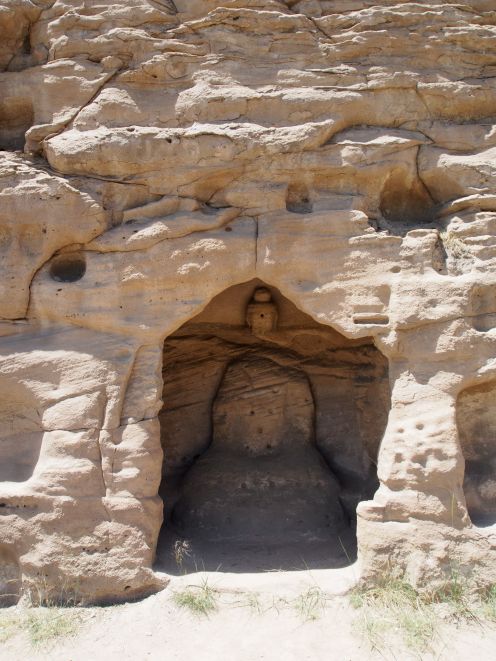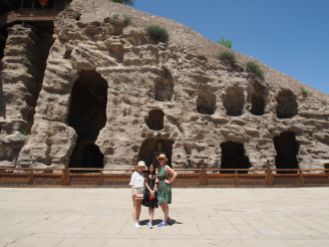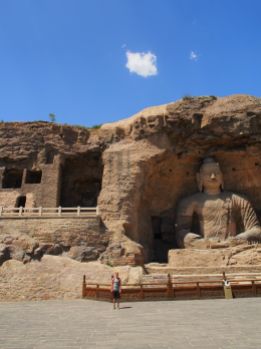The Wild Wild West – Yungang Grottoes, Hanging Monastery & the Sakyamuni Wooden Pagoda in Datong
Dragon Boat Festival 2017 – May 26th to May 29th
In May, an extended weekend during Chinese Dragon Boat Festival provided the opportunity for another roadtrip. Since we already been to Pingyao, we decided to discover the rest of Shanxi province and visit the city of Datong. Usually, an extra holiday has to be made up for with a working saturday, but luckily we had enough overtime (and understanding bosses) that we got four consecutive days to spend on the road. Friday evening Jelte went to Dongzhimen to pick up the car so that we could be on our way later that night in high hopes to dodge the majority of the holiday traffic. Although the streets of Beijing are always overcrowded with people, bikes, motorcycles, and cars, it actually payed off to make the extra effort and get started right after work, because we managed to arrive in Datong at around 1 am early the next morning and get some sleep in the Holiday Inn. Our sightseeing itinerary consisted of three major sights: first, the UNESCO World Heritage Sight of the Yungang Grottoes, the oldest collection of Buddhist carvings in China. Then the Hanging Monastery which was built into a cliff and is supported by long wooden stilts, and lastly the Yingxian Padoga, the world’s oldest and tallest wooden pagoda.
Big buddhas, carved caves & ancient artists – The Yungang Grottoes 云岗石窟
During the Northern Wei dynasty Datong was declared their capital and buddhism was developed from a minority religion to a major following. In the course of this expansion, the construction of these buddhist caves commenced in 460 A.D. and continued for more than 65 years. It can be seperated in three building phases: while the first phase was led by the monch Tan Yao who led the contruction of the five biggest caves, the second wave is remarkable for its twin and triplet caves. The third phase focussed on smaller caves and niches in which statues of buddha and other religious entities reside.
Climbing a (formely) firebreathing mountain – The Datong Volcanic cluster 大同火山群景区简介
A lesson we learned well then was that a detour isn’t always a bad thing. If we had followed the navigational system’s advice and hadn’t missed our exit on the way to the Hanging Monastery we would probably never visited the Datong volcanoes. It seems to become kind of a theme of our travels that we visit (or in this case accidentily stumble upon) a national geopark of some sort (see for example our trip to Inner Mongolia and the Hexingten Stone Forest). Here, over an area of around 77 km2 a group of 17 cinder cones are the main geological marker. We are pretty sure we climbed to the top of Hei Shan (Black Hill), the largest of the volcano group at an altitude of 1430m. It was sourrounded with deep trenches, which fractured the landscape into several pieces and could best be seen from the top of the Black Hill. It’s foot was covered with ancient frozen lava debries, of which even the larger pieces weighted less than one would expect, because they are riddled with air veins.
The Hanging Monastery 悬空寺
With the Yungang caves we got lucky because we visited them on the working saturday before the Dragon Boat Festival. Unfortunately, the following sunday we went to the Hanging Monastery was already a holiday, so naturally the place was swarming with tourists. Still the buidlings clinging to the face of the mountain were an impressive sight and were worth the 1 hour wait to get in.
 Happy Dragon Boat Festival 2017!!
Happy Dragon Boat Festival 2017!!
One of the things I love most about traveling in China is that at most sights, supplies are still fairly cheap to buy. Since we lost some time on our detour to the volcanoes, we decided to get something to eat for lunch before entering the Hanging Monasteries. As I already mentioned we went there during Dragon Boat Festival, so the traditional thing to eat are Zongzi, which is sticky rice usually filled with dried dates wrapped in banana leaves and pressed into a triangular shape. They are then steamed and served warm or cold right out of the their leafy packages.
For the time of our trip, we made Datong our basecamp and returned there after each sightseeing trip. A surprising sitenote about the city is the fact that – much like Pingyao – Datong also has a massive and intact city wall that is beautifully lit up after sundown. Built in 1372, it has a total length of 6.5 km and although we didn’t find the entrance, we’ve seen people walk on top of it.
Sakyamuni Pagoda 佛宫寺释迦塔 – The world’s largest wooden pagoda
As part of the Fogong Temple, the Sakyamuni (or Muta) pagoda was built in 1056 in Yingxian County. It is the oldest and tallest existent fully wooden multi-storey building still standing in China, and the world. From the exterior, the pagoda seems to have only five stories and two sets of rooftop eaves for the first story, yet the pagoda’s interior reveals that it has nine stories in all. Unfortunately visitors are no longer allowed to climb the octagonal structure, so we had to make due with a look from the outside. However, the ground floor was opened to the public and contains a very tall sitting Buddha statue. Not yet under UNESCO World heritage protection, the pagoda is almost a thousand years old and reaches a hight of close to 70m.
After visiting the Sakyamuni pagoda, we decided to head back home to Beijing again. As we had to check the mobile app for directions, we stopped on a small parking lot next to the road. An ironic reminder of the current brick up of Beijing’s Hutong just happened to be parked there – a broken down bus turned into a restaurant.




















































